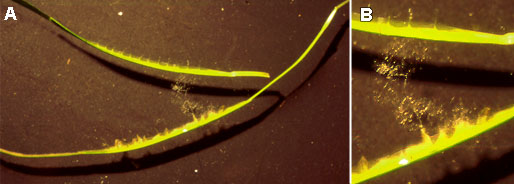AFRC Institute of Grassland and Environmental Research Plas Gogerddan, Aberystwyth, Dyfed SY23 3EB Wales, UK
White clover plants were subjected to either short-term developing water stress or long-term stable levels of water deficit. The hort-term stress reduced plant water status to about –2·0 MPa over 16 d. The long-term stress was less severe, but was sustained for several weeks. Long-term water stress promoted the production of inflorescences. However, water stress also increased floret abortion and the premature death of whole flower heads. The number of ovules per floret was decreased by water stress.
The most striking effect of both long- and short-term water deficit was to reduce pollen viability measured with the fluorochromatic assay. This was not an artefact of assay conditions. The pollen from water-stressed flower heads was not reversibly dehydrated; it did not score at similar viability to controls after incubation in conditions which hydrate pollen. In addition, the pollen from water-stressed plants lost viability more rapidly than pollen from well-watered plants after removal from the flower head.
The consequences of reduced pollen viability on seed set were investigated by hand-crossing within and between groups of plants maintained for several weeks at three levels of water supply. Flower heads pollinated with pollen from water-stressed plants set fewer seeds per floret than those pollinated with control pollen.
taken from www.jxb.oxfordjournals.org



0 comments:
Post a Comment